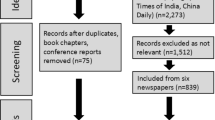Abstract
Modeling and forecasting damage from wind storms is a major issue for insurance companies. In this article, we focus on the sensitivity of estimations of return periods for extreme events with respect to modeling assumptions and the type of input data. Numerous variables play a role: the quality of data concerning the location of insured buildings and weather report homogeneity, missing updates for correcting non-stationarities concerning the insurance portfolio history, ground roughness or climate change, the evolution of the model after an unprecedented event such as the Lothar storm observed in 1999 in Europe, temporal aggregation of daily events over several days, where events could span over several days up to one week, and storm trajectories, which could change due to global warming or sweep larger areas. Our work explores three important aspects. First, we highlight the geographic heterogeneity of the spatial distribution of wind speeds and the resulting damages. Therefore, we propose to partition the French territory into 6 relatively homogeneous storm zones, based on the dependence among observed wind speeds and geographic distance. Second, we extend a storm index—defined in Mornet et al. (Risk Anal 35:2029–2056, 2015)—to take into account geographic heterogeneity, and we analyze its tail behavior to show the difficulties met to obtain reliable results on extreme events. Third, we explore the calculation of Solvency Capital Requirements based on a model that we propose for the annual claim amount distribution. The purpose of our analysis is to quantify and to point out the high level of uncertainty in the computation of return periods and of other quantities strongly influenced by extreme events.


















Similar content being viewed by others
Notes
Metropolitan France is organized into 95 departments which are administrative divisions.
AFA (Association Française de l’Assurance : French Insurance Association).
CCR (Caisse Centrale de Réassurance : Reinsurance Central Fund).
References
Bonazzi A, Cusack S, Mitas C, Jewson S (2012) The spatial structure of european wind storms as characterized by bivariate extreme-value copulas. Nat Hazards Earth Syst Sci 12(5):1769–1782
Coles S, Heffernan J, Tawn J (1999) Dependence measures for extreme value analyses. Extremes 2(4):339–365
Cooley D, Naveau P, Poncet P (2006) Variograms for spatial max-stable random fields. In: Bradley RC, Dehling H, Doukhan P, Neumann MH (eds) Dependence in probability and statistics. Statistics: lecture notes, vol 187. Springer, New York, pp 373–390
Donat MG, Pardowitz T, Leckebusch GC, Ulbrich U, Burghoff O (2011) High resolution refinement of a storm loss model and estimation of return periods of loss-intensive storms over Germany. Nat HazardsEarth Syst Sci 11(10):2821–2833
Douvillé C, Burbaud E (2012) Tempêtes, grêle et neige : Résultats 2010. Association française de l’assurance, FFSA and GEMA, Technical report
Embrechts P, Klüppelberg C, Mikosch T (1997) Modelling extremal events for insurance and finance. Springer, Berlin
Fawcett L, Walshaw D (2016) Sea-surge and wind speed extremes: optimal estimation strategies for planners and engineers. Stoch Environ Res Risk Assess 30(2):463–480
Ferro CAT, Segers J (2003) Inference for clusters of extreme values. J R Stat Soc 65(2):545–556
Gilleland E, Ribatet M, Stephenson AG (2013) A software review for extreme value analysis. Extremes 16(1):103–119
Guyon X (2007) Statistique spatiale. Technical report, Conférence S.A.D.A. 07—Cotonou—Benin
Hall P (1990) Asymptotic properties of the bootstrap for heavy-tailed distributions. Ann Probab 5:1324–1360
Hoskins BJ, Hodges KI (2002) New perspectives on the northern hemisphere winter storm tracks. J Atmos Sci 59(6):1041–1061
Katz RW, Brown BG (1992) Extreme events in a changing climate: variability is more important than averages. Clim Change 21:289–302
Kaufman L, Rousseeuw PJ (2009) Finding groups in data: an introduction to cluster analysis. Wiley, New York
Kim JS, Kim ST, Wang L, Wang X, Moon YI (2016) Tropical cyclone activity in the northwestern pacific associated with decaying central pacific el niños. Stoch Environ Res Risk Assess 30(5):1335–1345
Klawa M, Ulbrich U (2003) A model for the estimation of storm losses and the identification of severe winter storms in Germany. Nat Hazards Earth Syst Sci 3:725–732
Liberato MLR, Pinto JG, Trigo RM, Ludwig P, Ordóñez P, Yuen D, Trigo IF (2013) Explosive development of winter storm xynthia over the subtropical north atlantic ocean. Nat Hazards Earth Syst Sci 13(9):2239–2251
Luzi M (2013) Travaux sur les historiques tempêtes. Technical report
MacKenzie CA (2014) Summarizing risk using risk measures and risk indices. Risk Anal 34(12):2143–2162
Mornet A (2015) Contributions to risk assessment in wind storm and car insurance. PhD thesis, Université Lyon I—ISFA
Mornet A, Opitz T, Luzi M, Loisel S (2015) Index for predicting insurance claims from wind storms with an application in france. Risk Anal 35(11):2029–2056
Mutahara M, Haque A, Khan MSA, Warner JF, Wester P (2016) Development of a sustainable livelihood security model for storm-surge hazard in the coastal areas of Bangladesh. Stoch Environ Res Risk Assess 30(5):1301–1315
Thomson P, Mullan B, Stuart S (2014) Estimating the slope and standard error of a long-term linear trend fitted to adjusted annual temperatures. Statistics Research Associates Ltd
Thouret JC, d’Ercole R (1996) Vulnérabilité aux risques naturels en milieu urbain: effets, facteurs et réponses sociales. Cah des Sci Hum 32(2):407–422
Wang W, Bobojonov I, Härdle WK, Odening M (2013) Testing for increasing weather risk. Stoch Environ Res Risk Assess 27(7):1565–1574
Winkler RL (2015) The importance of communicating uncertainties in forecasts: overestimating the risks from winter storm juno. Risk Anal 35(3):349–353
Acknowledgements
For this study, the authors have received a research grant which allowed them to work on the data series of 192 meteorological stations of Météo France over a period of 50 years. This work was supported by Allianz France. The authors thank the research chair Actuariat Durable sponsored by Milliman for additional support, as well as Sidney Resnick and Gennady Samorodnitsky for relevant comments.
Author information
Authors and Affiliations
Corresponding author
Rights and permissions
About this article
Cite this article
Mornet, A., Opitz, T., Luzi, M. et al. Wind storm risk management: sensitivity of return period calculations and spread on the territory. Stoch Environ Res Risk Assess 31, 1977–1995 (2017). https://doi.org/10.1007/s00477-016-1367-7
Published:
Issue Date:
DOI: https://doi.org/10.1007/s00477-016-1367-7




